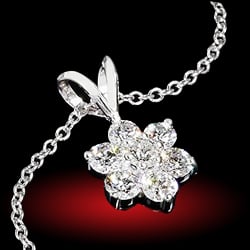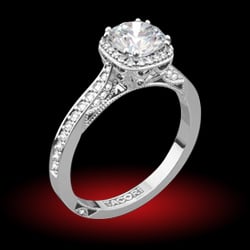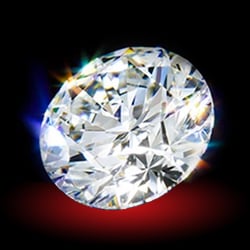starryeyed
Ideal_Rock
- Joined
- Nov 6, 2006
- Messages
- 2,398
I''ve been looking at some mounted diamonds, where the diamond could not be weighed. This info from NiceIce.com was very helpful in determining the approximate carat weight from micrometer measurements.
Here are the GIA formulas and tables for calculating the carat weight of mounted diamonds:
Round Brilliant Cut Diamond Formula: average diameter x average diameter x depth x 0.0061 = approximate carat weight.
To determine the average diameter of a diamond add the length plus the width and divide it by two. Keep in mind that these formulas are for approximation purposes ONLY and that the actual weight of the diamond might be slightly different when unmounted.
Oval Brilliant Cut Formula: average diameter x average diameter x depth x 0.0062 = approximate carat weight.
Heart Shape Brilliant Formula: length x width x depth x 0.0059 = approximate carat weight.
Triangular Brilliant (Trillion) Formula: length x width x depth x 0.0057 = approximate carat weight.
Emerald Cut, Princess Cut, and Quadrillion Cut Diamonds Formula: length x width x depth x adjustment factor (below) = approximate carat weight.
Adjustment Factor: First determine the diamonds length to width ratio by dividing the diamonds length by it''s width and determining it''s relationship to 1.00 For example, if a diamonds length is 7.22 mm, width is 3.90 mm and it''s depth is 2.50 mm, then the length to width ratio would be calculated by dividing 7.22 by 3.90 which would equal 1.851282, which is then rounded to 1.85 and expresses as 1.85 to 1.00 or stated for appraisal purposes as 1.85:1.00 Once the length to width ratio is determined, use the adjustment factors below in the aforementioned formula to estimate the diamond''s approximate carat weight.
Length to Width Ratio: Adjustment Factor:
1.25:1.00 0.0080
1.50:1.00 0.0092
2:00:1.00 0.0100
2.50:1.00 0.0106
In the example above, the diamond''s length to width ratio is 1.85:1.00 which does not appear on the table above. Since the ratio is close to 2.00:1.00, you use 0.0110 as your adjustment factor. To make your estimate more accurate, interpolate an adjustment factor between those for 1.50:1.00 and 2.00:1.00. Here, 0.0098 would be good.
Marquise Cut Brilliant Diamond Formula: length x width x depth x adjustment factor.
Length to Width Ratio: Adjustment Factor:
1.50:1.00 0.00565
2.00:1.00 0.00580
2:50:1.00 0.00585
3.00:1.00 0.00595
Pear Shape Brilliant Cut Diamond Formula: length x width x depth x adjustment factor.
Length to Width Ratio: Adjustment Factor:
1.25:1.00 0.00615
1.50:1.00 0.00600
1.66:1.00 0.00590
2.00:1.00 0.00575
So there you have it, if you want to verify the carat weight of a mounted diamond all you have to do is ask the jeweler for a micrometer or the diamond''s dimensions and use the formulas above.
from www.niceice.com/caratweight.htm
Here are the GIA formulas and tables for calculating the carat weight of mounted diamonds:
Round Brilliant Cut Diamond Formula: average diameter x average diameter x depth x 0.0061 = approximate carat weight.
To determine the average diameter of a diamond add the length plus the width and divide it by two. Keep in mind that these formulas are for approximation purposes ONLY and that the actual weight of the diamond might be slightly different when unmounted.
Oval Brilliant Cut Formula: average diameter x average diameter x depth x 0.0062 = approximate carat weight.
Heart Shape Brilliant Formula: length x width x depth x 0.0059 = approximate carat weight.
Triangular Brilliant (Trillion) Formula: length x width x depth x 0.0057 = approximate carat weight.
Emerald Cut, Princess Cut, and Quadrillion Cut Diamonds Formula: length x width x depth x adjustment factor (below) = approximate carat weight.
Adjustment Factor: First determine the diamonds length to width ratio by dividing the diamonds length by it''s width and determining it''s relationship to 1.00 For example, if a diamonds length is 7.22 mm, width is 3.90 mm and it''s depth is 2.50 mm, then the length to width ratio would be calculated by dividing 7.22 by 3.90 which would equal 1.851282, which is then rounded to 1.85 and expresses as 1.85 to 1.00 or stated for appraisal purposes as 1.85:1.00 Once the length to width ratio is determined, use the adjustment factors below in the aforementioned formula to estimate the diamond''s approximate carat weight.
Length to Width Ratio: Adjustment Factor:
1.25:1.00 0.0080
1.50:1.00 0.0092
2:00:1.00 0.0100
2.50:1.00 0.0106
In the example above, the diamond''s length to width ratio is 1.85:1.00 which does not appear on the table above. Since the ratio is close to 2.00:1.00, you use 0.0110 as your adjustment factor. To make your estimate more accurate, interpolate an adjustment factor between those for 1.50:1.00 and 2.00:1.00. Here, 0.0098 would be good.
Marquise Cut Brilliant Diamond Formula: length x width x depth x adjustment factor.
Length to Width Ratio: Adjustment Factor:
1.50:1.00 0.00565
2.00:1.00 0.00580
2:50:1.00 0.00585
3.00:1.00 0.00595
Pear Shape Brilliant Cut Diamond Formula: length x width x depth x adjustment factor.
Length to Width Ratio: Adjustment Factor:
1.25:1.00 0.00615
1.50:1.00 0.00600
1.66:1.00 0.00590
2.00:1.00 0.00575
So there you have it, if you want to verify the carat weight of a mounted diamond all you have to do is ask the jeweler for a micrometer or the diamond''s dimensions and use the formulas above.
from www.niceice.com/caratweight.htm








300x240.png)